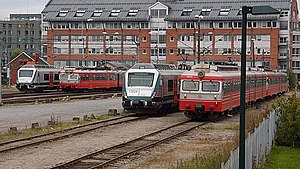Oslo Commuter Rail
 |
|
 |
|
| Overview | |
|---|---|
| Owner | Norwegian National Rail Administration |
| Locale | Eastern Norway |
| Transit type | Commuter rail |
| Number of lines | 8 |
| Number of stations | 128 |
| Website | www |
| Operation | |
| Began operation | 1902 |
| Operator(s) |
Norges Statsbaner NSB Gjøvikbanen |
| Number of vehicles | 82 Class 69 36 Class 72 24 Class 74 26 Class 75 |
| Technical | |
| System length | 553 kilometres (344 mi) |
| Track gauge | 1,435 mm (4 ft 8 1⁄2 in) standard gauge |
| Electrification | 15 kV 16 2⁄3 Hz AC |
| Top speed | 160 km/h (99 mph) |
Oslo Commuter Rail (Norwegian: NSB Lokaltog Østlandet) is a commuter rail centered in Oslo, Norway, connecting the capital to six counties in Eastern Norway. The system is operated by the Norwegian State Railways (NSB) and its subsidiary NSB Gjøvikbanen, using Class 69 and Class 72 electric multiple units (EMU). The network spans eight routes and 128 stations, with Oslo Central Station (Oslo S) as the central hub. The trains run on 553 kilometers (344 mi) of electrified mainline railway owned by the Norwegian National Rail Administration. Deficits are financed by the Norwegian Ministry of Transport and Communications, although the network also has a ticketing cooperation with Ruter, the public transport authority in Oslo and Akershus. The network is the longest commuter rail network in the Nordic countries, and among top ten in Europe.
The commuter rail operates mainly within Greater Oslo and two of the lines only provide services within the urban area. Six of the lines span beyond the urban area, reaching the counties of Østfold, Hedmark, Oppland and Buskerud. The system is also an airport rail link to Oslo Airport, Gardermoen. West of Oslo, the system uses the Drammen, Asker, Spikkestad and Sørland lines, north of Oslo it uses the Gjøvik Line, east of Oslo it uses the Trunk, Gardermoen and Kongsvinger lines and south of Oslo it follows the Østfold and Eastern Østfold lines.
...
Wikipedia
